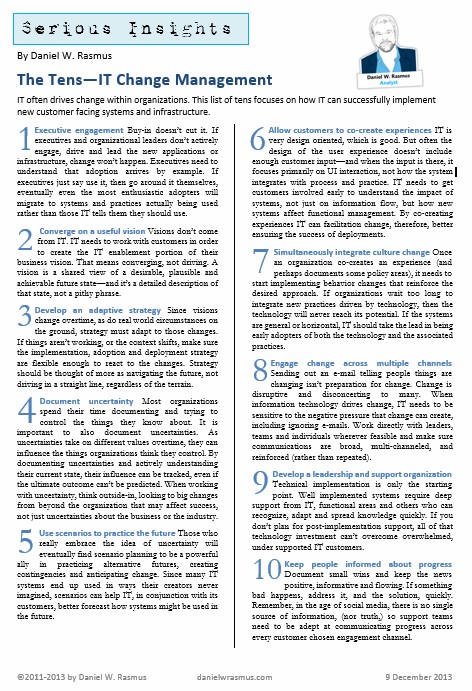
IT often drives change within organizations. This list of tens focuses on how IT can successfully implement new customer facing systems and infrastructure.
1. Executive engagement Buy-in doesn’t cut it. If executives and organizational leaders don’t actively engage, drive and lead the new applications or infrastructure, change won’t happen. Executives need to understand that adoption arrives by example. If executives just say use it, then go around it themselves, eventually even the most enthusiastic adopters will migrate to systems and practices actually being used rather than those IT tells them they should use.
2. Converge on a useful vision Visions don’t come from IT. IT needs to work with customers in order to create the IT enablement portion of their business vision. That means converging, not driving. A vision is a shared view of a desirable, plausible and achievable future state—and it’s a detailed description of that state, not a pithy phrase.
.3 Develop an adaptive strategy Since visions change overtime, as do real world circumstances on the ground, strategy must adapt to those changes. If things aren’t working, or the context shifts, make sure the implementation, adoption and deployment strategy are flexible enough to react to the changes. Strategy should be thought of more as navigating the future, not driving in a straight line, regardless of the terrain.
4. Document uncertainty Most organizations spend their time documenting and trying to control the things they know about. It is important to also document uncertainties. As uncertainties take on different values overtime, they can influence the things organizations think they control. By documenting uncertainties and actively understanding their current state, their influence can be tracked, even if the ultimate outcome can’t be predicted. When working with uncertainty, think outside-in, looking to big changes from beyond the organization that may affect success, not just uncertainties about the business or the industry.
5. Use scenarios to practice the future Those who really embrace the idea of uncertainty will eventually find scenario planning to be a powerful ally in practicing alternative futures, creating contingencies and anticipating change. Since many IT systems end up used in ways their creators never imagined, scenarios can help IT, in conjunction with its customers, better forecast how systems might be used in the future.
6. Allow customers to co-create experiences IT is very design oriented, which is good. But often the design of the user experience doesn’t include enough customer input—and when the input is there, it focuses primarily on UI interaction, not how the system integrates with process and practice. IT needs to get customers involved early to understand the impact of systems, not just on information flow, but how new systems affect functional management. By co-creating experiences IT can facilitation change, therefore, better ensuring the success of deployments.
7. Simultaneously integrate culture change Once an organization co-creates an experience (and perhaps documents some policy areas), it needs to start implementing behavior changes that reinforce the desired approach. If organizations wait too long to integrate new practices driven by technology, then the technology will never reach its potential. If the systems are general or horizontal, IT should take the lead in being early adopters of both the technology and the associated practices.
8. Engage change across multiple channels Sending out an e-mail telling people things are changing isn’t preparation for change. Change is disruptive and disconcerting to many. When information technology drives change, IT needs to be sensitive to the negative pressure that change can create, including ignoring e-mails. Work directly with leaders, teams and individuals wherever feasible and make sure communications are broad, multi-channeled, and reinforced (rather than repeated).
9. Develop a leadership and support organization Technical implementation is only the starting point. Well implemented systems require deep support from IT, functional areas and others who can recognize, adapt and spread knowledge quickly. If you don’t plan for post-implementation support, all of that technology investment can’t overcome overwhelmed, under supported IT customers.
10.Keep people informed about progress Document small wins and keep the news positive, informative and flowing. If something bad happens, address it, and the solution, quickly. Remember, in the age of social media, there is no single source of information, (nor truth,) so support teams need to be adept at communicating progress across every customer chosen engagement channel.
Click the image to download this PDF from Daniel W. Rasmus.


